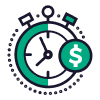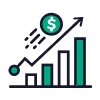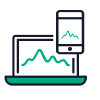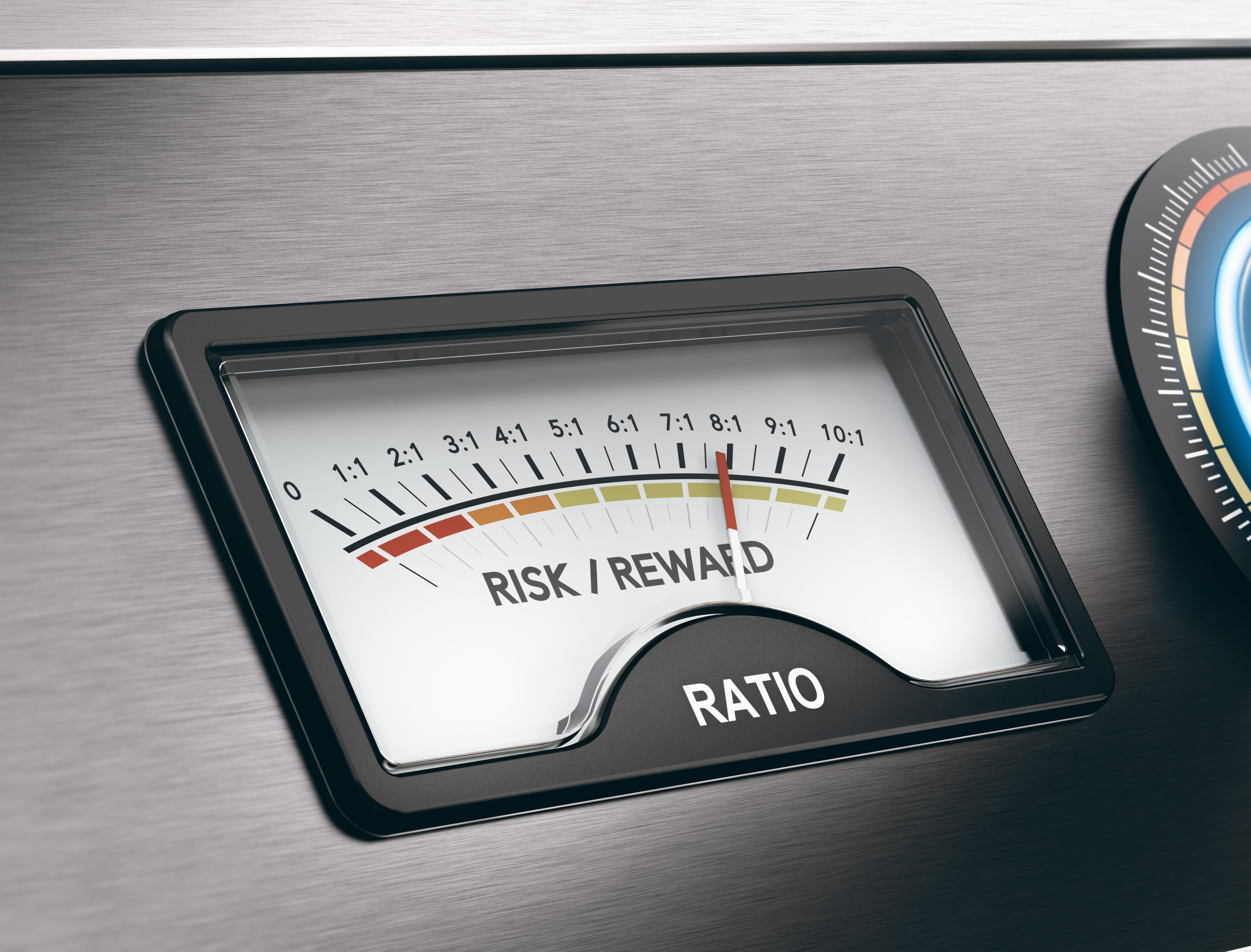What is CFD? CFD definition
Whether you are a novice day trader or a professional investor, you probably will have asked yourself: "What are CFDs?" or "What is CFD trading?". CFDs are easy to understand, yet powerful financial instruments, providing exceptional opportunities to earn profits through day trading and investing.
A CFD (Contract for Difference) is a popular financial instrument that allows to profit from daily price changes of a wide array of financial assets, such as forex, cryptocurrencies, shares, indices, and commodities.
A CFD is a cash-settled derivative, meaning when a trader buys a CFD, he or she doesn't buy the underlying asset itself. Instead, a trader enters into a contract with a broker to receive any difference in price between the time of purchase and sale of the underlying asset.
As a result, CFD trading provides full exposure to capital gains (and losses) from the underlying assets tradable on global financial markets, but with lower trading costs, compared to traditional asset exchanges.
What is CFD trading?
CFD trading essentially means buying CFDs at a low price, then selling them at a higher price, and making a profit from the price change. To make a profit, you should:
- Buy a CFD (open a long position) when you believe the price of an underlying asset will rise, or
- Sell a CFD (open a short position) when you believe the price of an underlying asset will decline
If you go long (buy) and the price of an underlying asset rises, Monfex.com will pay you the difference. If the price of an underlying asset declines over this interval, you will incur a loss.

Traders use CFDs to buy and sell a wide array of assets - forex, cryptocurrencies, stocks, indices, and commodities — all by paying a small portion of the asset's price. An essential advantage of CFDs is that they are highly leveraged instruments.
Leverage allows traders to earn significant profits from small initial deposits because the profit is based on the overall position value. Note that leverage magnifies the asset's movements both up and down, and the losses could be significant.
How to earn money by trading CFDs?
As a CFD day trader, you begin a day by analyzing financial markets. Traders apply different analytical tools, such as technical and fundamental analyses, to discover profitable investment opportunities and trade setups. The purpose of doing a market analysis is to identify financial instruments that are expected to go up or down in price.
When a trader identifies a potentially profitable trade setup, then he or she establishes a market position. Meaning, a trader buys those financial assets whose prices are expected to rise and sells short the ones whose prices are expected to decline.
After a while, if successful, a trader closes market positions and realizes a profit. The following is a detailed example of a lifecycle of a speculative CFD trade.
You buy 1 lot of Pound Sterling vs. the US Dollar.
Pound Sterling is the national currency of the United Kingdom. The trade symbol
is GBP/USD.
Buying 1 lot of GBPUSD is equivalent to buying 100,000 Pounds.
Assume, the market price is $1.2900, and the leverage is set to 100x.
1 lot (trade size) * 100,000 Pounds (lot size) * $1.2900 (ask price) = $129,000.
Leverage of 100x means that you need 1/100th (or 1%) of the trade size in equity, meaning $1,290 only (1% * $129,000 = $1,290)
Let’s assume that, after you enter a trade, the price goes up by 0.5% to 1.2965.
equal to $129,000 * (1.2965 — 1.2900)
Your trading account will increase by $839 to $2,129 (equal to $1,290 initial equity plus the profit of $839). The return on equity generated in this trade would be 65% ($839 / $1,290).
As you can see from this simple, yet realistic example, a single CFD trade transaction for a UK CFD trader could have generated a 65% return on equity, given a 0.5% increase in GBPUSD and the multiplying effect of a 100x leverage.
What are the benefits of CFD trading?
The key advantages of CFD trading include:
- Simplicity of day trading and speculation
- Broad range of CFD markets worldwide
- Small spreads and no commissions
- High leverage (low initial outlay)
- Long and short positions
- Short-selling is easy
1 The key advantages of CFD trading include:
The key advantage of CFDs is their simplicity. CFDs allow you to speculate on asset prices and earn profits without owning assets outright. A CFD is a derivative, settled in cash, which essentially means that a contract is created between the trader and Monfex.com, where we agree to pay the trader the difference between the asset's purchase price and the selling price when the trade is closed. Hence the term 'a Contract for Difference (CFD)'.
If in a given trade, the difference is positive, meaning the trader makes a profit, Monfex.com pays the trader. Otherwise, if the difference is negative, the trader pays Monfex.com.
Importantly, Monfex.com does not bear any dealing risks because our market-making engine hedges all CFD positions against the real assets bought on international exchanges. In addition, substantial trade volumes are matched internally by the Monfex's CFD trading platform, which means that traders trade peer-to-peer, not against the broker.
These risk-management mechanisms, implemented at Monfex.com, create a seamlessand secure CFD trading experience for day traders.
2 Broad range of CFD markets
There are hundreds of thousands of financial assets that are tradable and investable all over the world. The primary asset classes include Forex, Cryptocurrencies, Shares, Indices, and Commodities.

Even though advancements in technology have made it much easier to trade various asset classes, many traders are still not able to trade easily due to the legal restrictions in their country of residence or high brokerage costs. CFD trading solves these problems and makes it much easier to speculate on price changes on virtually any financial asset without owning the asset itself.
The main advantage of trading CFDs at Monfex.com is that we allow accessing a wide array of CFD markets and assets in a single CFD trading platform. At present, we provide our clients access to Forex, Cryptocurrency, Shares, Indices, and Commodities markets, and every month, we are expanding our list of tradable financial instruments.
With Monfex.com, you don't need to have multiple brokerage accounts to trade different asset classes - you can do it all on Monfex.com
3 Small spreads in CFD trading
The second biggest advantage of CFDs is low trading costs and small spreads. A spread is the difference between the Ask price, at which you can buy a financial instrument, and the Bid price, at which you can sell a financial instrument, such as a CFD.
The high popularity of CFD trading has made major CFD markets, such as Forex CFDs, Cryptocurrency CFDs, and Equity CFDs, highly liquid. High liquidity means that the daily trade volumes are high, which leads to small bid/ask spreads.

A small spread allows traders to profit even from small market moves and to apply profitable day trading strategies. Also, since the spread is a form of trading costs, a lower spread means that a trader pays less and retains more money in profits.
4 Leverage in CFD trading
A Contract for Difference (CFD) is a leveraged instrument. This means two things:
- Buying a CFD requires a low initial outlay. For instance, with the 20x leverage, you can buy one Bitcoin worth $10,000 by depositing only $500 in equity.
- Traders can make substantial gains even from small market moves.

Leverage essentially means that a portion of the asset's purchase price is financed by borrowed capital, and the trader's equity is 'leveraged' for larger exposure to potential profits due to higher position size.
Leveraged CFD trading means buying assets on margin by borrowing some of the purchase price. The borrowed money is provided by Monfex.com and is called the margin loan. The ratio between the value of the position and the trader's equity in it is called leverage.
The following is a simple example: At Monfex.com, the amount of leverage for EUR/USD
is 100x, which means that a trader must supply only 1% of the
purchase price — the initial margin requirement — and the rest 99%
will be supplied by us — the broker.
100 leverage = 100% position / 1% equity.
Leveraged CFD trading can greatly increase the potential gains for a given amount of trader's equity because the trader can buy more assets with leverage than he could otherwise. A highly leveraged position is large relative to the trader's equity that supports it.

Thus, for a long position, a trader earns greater profits when prices rise and suffer greater losses when prices decline. The reverse is true for a short (sell) position.
the trader will get a 200% return on equity (100x leverage times 2%).
If the EURUSD declines by 0.5%, the trader holding a long position
would lose 50% of his (or her) equity.
In a latter case, a trader would need to deposit additional funds with Monfex.com to increase the amount of equity in the leveraged position. Otherwise, the stop-out could be triggered, in which case we would close the leveraged position to prevent further losses and thereby secure repayment of the margin loan.
Leveraged CFD trading is an effective way for day traders to increase potential profits up to 100 times and receive large returns from small investments. Importantly, you cannot lose more money than you deposited in your trading account, which makes leveraged CFD trading secure for all market participants.
5 Long and short positions in CFD trading
When a trader "goes long" or "opens a long CFD position", it means that he or she has bought the CFD contract and expects the price of the underlying asset to go up. If, in fact, the price will go up, the trader will earn a profit.

When a trader "goes short" or "opens a short CFD position", it means that he or she has sold the CFD contract and expects the price of the underlying asset to go down (to decline). If, in fact, the price will go down, the trader will earn a profit.

6 Benefits of short selling CFDs
The ability to sell 'short' any asset is a significant advantage of CFDs, compared to traditional asset exchanges, where short selling is not usually possible.
Downward price trends are common on markets and, when the fundamentals of a particular asset deteriorate, its price may decline rather abruptly and significantly. Therefore, traders can capitalize on price declines and make substantial gains not only when the market goes up, but when it goes down as well.
On asset exchanges, if an investor believes the price of an asset will increase, he can take a 'long' position - meaning, buy the asset. In contrast, if an investor believes the asset's price will decline, he cannot sell it outright, unless he borrows the asset from the broker. The underlying logic is that, on asset exchanges, you cannot sell an asset that you don't own.

However, on CFD trading platforms, traders can easily go short on a wide variety of assets. In this respect, CFDs make trading more effective while giving the same exposure to a variety of financial markets and producing higher capital gains due to the effect of leverage.
Experienced traders sell short CFDs to generate abnormal returns faster compared to investing. There are multiple factors making short-selling CFDs so attractive. Negative macroeconomic trends, trade wars, and geopolitical disputes can undermine investors' confidence and cause the prices of risky assets to fall almost instantaneously. Deteriorating fundamental data of a particular company can cause its stock to fall dramatically to. In such periods, sellers can make abnormal returns fast by short selling CFDs, instead of waiting for an uptrend and going long.
The following are examples of significant market declines:
- The Dow Jones plunged 22% on Black Monday - October 22, 1987
- The dot-com crash of 2002, when the Nasdaq Index tumbled by 76.81%
- The 2008 Financial Crisis and the stock market crash by 57%
- Bitcoin 80% fell during 2014 and 2018.
- The Flash Crash on May 6, 2010, when US equity and futures prices dropped nearly 10% in a matter of minutes.
How to become a profitable CFD trader?
To achieve success in CFD trading, you have to learn how to analyze the markets and identify profitable trade ideas (trade setups). Your ability to apply different analytical tools, such as technical indicators and chart patterns, understanding of macroeconomic trends, and the effects of important corporate and political news, will give you unique insights into the future of financial markets and asset prices.
The most profitable traders are the ones who have accurate price forecasts. To be able to generate accurate price forecasts, a trader has to develop a trading strategy (trading plan). The process of trading strategy development is continuous because the trends and volatility of financial markets are constantly changing.
Every trading strategy is supported by a set of rules, suggesting to a trader when to buy or sell a particular asset. Trading strategies can vary from simple combinations of technical indicators and chart patterns to more complex ones, taking into account macroeconomic trends and politics.
When you design a profitable trading strategy, your CFD trading will become more stable, with consistent profits, since every trade setup will have a reasonable basis and a high probability of success. Such CFD trading, supported by a professional trading plan, will make you a profitable CFD trader.
How to start trading CFDs today?
To become a CFD trader you have to open a brokerage account at Monfex.com. Follow these two simple steps:
- Sign up at Monfex.com to create a trading account.
- Deposit funds to your trading account.
Then you will obtain access to the Monfex.com’s trading platform and will be able to buy and sell CFDs.
Why trade CFDs with Monfex.com?
- 24/7 Customer Support
- Personal Account Manager
- Reliable custody of funds
- Up to 400x leverage
- 0% commissions /low spreads
- Daily market analyses and trading ideas
- 70 technical indicators
- 6 Chart types
- 9 timeframes
- Trading Academy
- Webinars
- Step-by-step guides and free courses
FAQs
In financial markets, a contract is an agreement among two traders to do something in the future. Contracts are also called derivatives. There are many contract types, such as forward, futures, options, swaps, and insurance contracts. The values of most contracts depend on the value of an underlying asset, hence the term derivative. The underlying asset may be a forex currency pair, a cryptocurrency pair, a stock of a public company, a stock market index, a commodity, or virtually any other financial asset.
The emergence of Contracts for Difference (CFDs) trading has been one of the most significant innovations in the trading industry. The concept of CFD trading is intuitive and straightforward yet powerful and profound. And, despite its simplicity, CFD trading is broadly accepted by traders and investors all over the world.
Drivers underlying extremely rapid growth in CFD trading over the past decade include expansion of types of tradable financial assets worldwide, a growing perception of trading as a financially rewarding business, and technological advances that enabled online day trading.
Among the critical technological advances associated with the emergence of CFD trading, are the development of fast and secure online CFD trading platforms, high-frequency trading, leveraged trading, short-selling, and peer-to-peer (P2P) orders' execution.
Forex stands for 'foreign exchange' and represents the market where currencies issued by national monetary authorities are traded against each other. Measured by daily turnover, the FX market is by far the world's largest financial market. As of 2019, the daily trading turnover on the forex market amounts to approx. 10 trillion USD, which is about 50 times larger than the global daily turnover on stock markets.
Crypto trading means the activity of buying and selling cryptocurrency pairs on the crypto market. Crypto trading is especially attractive because of its high volatility and very strong trends - much higher, as compared to forex and equity markets.
Bitcoin, for example, is by far the fastest-growing financial asset in the world.
- Over the past 9 years, from 2011 to 2019 YTD, the Bitcoin price has appreciated by 200,000%.
- Over the past 5 years, the Bitcoin price has risen by 2,500%
















